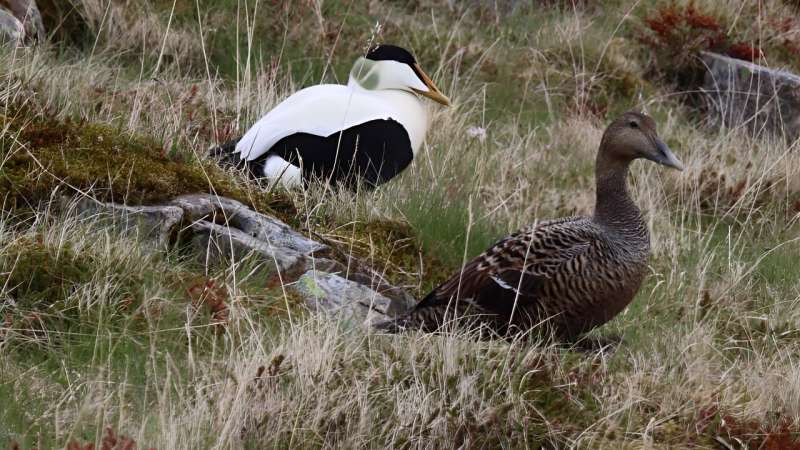This article has been reviewed according to Science X's editorial process and policies. Editors have highlighted the following attributes while ensuring the content's credibility:
fact-checked
peer-reviewed publication
trusted source
proofread
Citizen Science reveals which predator is causing trouble for eider ducks in Iceland

Many birds on islands are threatened by invasive species. A prominent example is the New Zealand kiwi, whose population has been severely reduced by ferrets and other invasive predators. But other birds on other islands are also affected.
In Iceland, a team of researchers led by the University of Iceland's Research Center at Snæfellsnes and IGB has used unusual Citizen Science data from several decades to show that the American mink has decimated the native eider duck in the Brokey archipelago by about 60%.
Yet eider ducks—unlike the New Zealand kiwi—are quite accustomed to predatory mammals. In another Icelandic island landscape, the Purkey archipelago, the return of the native Arctic fox had no discernible impact on the eider population—presumably due to the common evolutionary history in which the eiders have developed suitable defense strategies against the fox. The study has been published in Ecology Letters.
Species communities on islands tend to have smaller populations and geographical ranges, or have few or no defense mechanisms against predators, making them more vulnerable to the negative impacts of biological invasions than those on the mainland. This is especially true for ground-nesting bird species threatened by invasive predatory mammals, such as the Icelandic eider (Somateria mollissima borealis).
About 16% of the global and 32% of the European eider population live in Iceland (BirdLife International, 2019), where it is of great ecological, economic and cultural importance. About 3,000 kg of eider down are extracted from the nests each year and processed into high-quality clothing and blankets.
Data treasure: 123 years of collecting down and documenting nests
Eider down has been collected in Iceland for centuries, and the number of nests per island is accurately documented each year by local families. This provided long-term records of nests from two island groups, covering 95 islands over 123 years and 39 islands over 27 years, respectively.
"This unusual Citizen Science data is very valuable because of the long periods over which it has been collected. The families collecting this data not only know their islands better than anyone else, but also the eiders, their enemies and other animals that live on the islands," explained Jón Einar Jónsson, from the University of Iceland, one of the study's lead authors.
Island bird adapted to native nest predator, but not to the invasive mink
Using these extraordinary data sets, the research team was able to determine that the introduction of the invasive semi-aquatic American mink (Neogale vison) has had a stronger impact on the population dynamics of eider ducks than climate change: the invasive predator has reduced the number of eider nests in the Brokey archipelago by about 60%.
In the Purkey archipelago, however, the researchers documented a response of eiders to the return of the native Arctic fox that is likely a result of joint evolutionary history: The birds build their nests on small islands inaccessible to the fox—a strategy that keeps out the land-only Arctic fox, but not the semi-aquatic mink, which is a very good swimmer. "The only native mammalian predator is the Arctic fox. Over the course of evolution, the eiders have adapted their defense mechanisms to this enemy. But these do not work against the new enemy, the invasive American mink," said IGB researcher Florian Ruland who co-led the study.
Long-term data about biological invasions are highly valuable
The study illustrates the importance of long-term data to investigate impacts of biological invasions. Temporal changes of biological invasions and their impacts have been investigated since 2015 by the Invasion Dynamics Network, which was initiated by Jonathan Jeschke, who is senior author of the study and based at IGB and Freie Universität Berlin, together with Florian Ruland.
"Long-term data is rare in ecology, unfortunately, which makes high-quality data covering the decades before and after the introduction of an invasive species a real treasure chest of information," said Fiona Rickowski who co-led the study and is carrying out her doctoral dissertation at IGB and Freie Universität Berlin with a focus on the invasive American mink.
More information: Jón Einar Jónsson et al, Long-term data reveal contrasting impacts of native versus invasive nest predators in Iceland, Ecology Letters (2023). DOI: 10.1111/ele.14313. onlinelibrary.wiley.com/doi/10.1111/ele.14313
Journal information: Ecology Letters
Provided by Forschungsverbund Berlin e.V. (FVB)




















